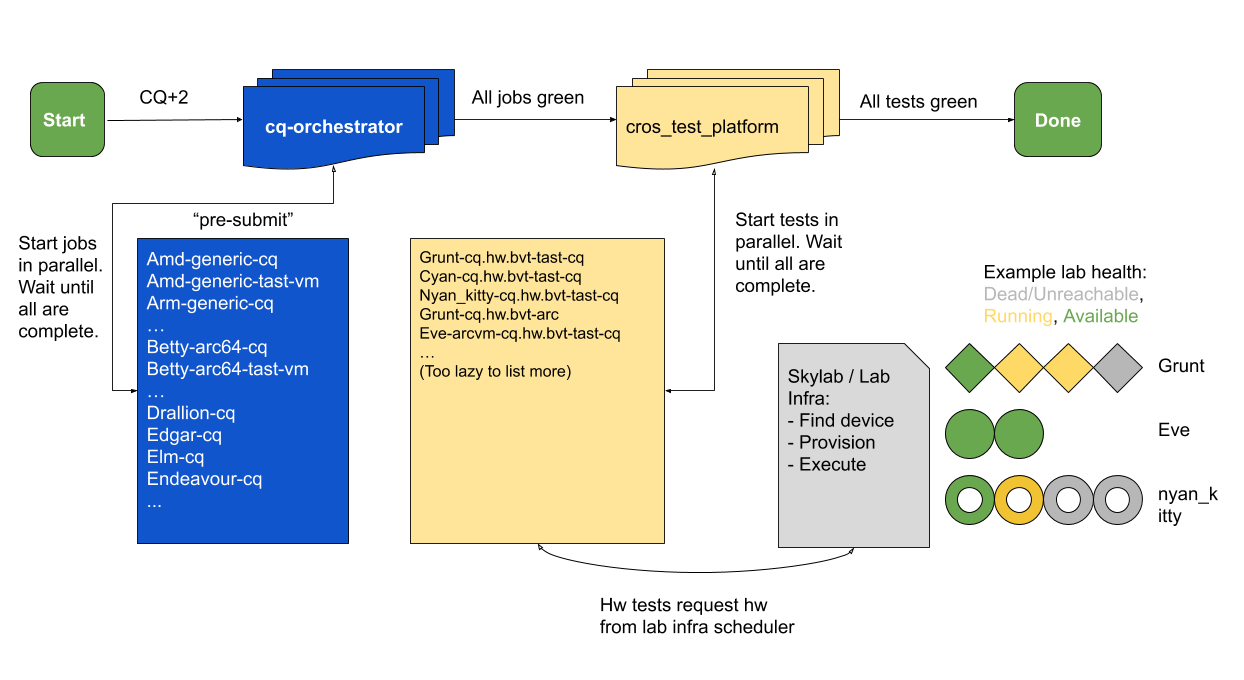Life of a ChromeOS commit
This document provides a brief overview of how ChromeOS changes get committed and tested.
For details on Chrome changes, see Life of a Chrome commit on ChromeOS.
Create a ChromeOS change
Make and upload changes
See the developer guide for how to create a branch and make changes.
Once a change is completed and tested locally, upload it to chromium-review:
repo upload --current-branch .
Have your change reviewed
Use chromium-review to review your change and prepare it for the commit queue.
See the gerrit workflow for details.
The ChromeOS commit pipeline
As of January 2020, ChromeOS is using the parallel CQ. This documentation has been updated to reflect how that behaves.
A gross simplification of the ChromeOS Continuous Integration (CI):

The CQ collects all changes in the patch series, along with any changes linked
via Cq-Depend in the commit messages, and applies them to tip of tree (ToT).
The result is then built and tested by the cq-orchestrator.
The cq-orchestrator starts jobs to compile and unit test a CL across a variety
of boards (see chromeos-cq builders). All of the jobs run in parallel and the
cq-orchestator will collect all the results. If there are failures, the
cq-orchestrator is a good place to start debugging what went wrong.
Once all the jobs are done, the cq-orchestrator kicks off cros_test_platform
which starts and monitors all the hardware tests. Tests run by
cros_test_platform require hardware resources and they will request this from
the lab infrastructure that is currently in place (Skylab as of Jan 2020). If
the hardware resource needed by the test isn't available, the test will wait for
it to become available or timeout after several hours (exact time depends on the
current state of builds and the health of the lab; ask in go/cros-oncall if
you need a more accurate number). Gerrit displays all the jobs started by
cq-orchestrator but not the jobs started by cros_test_platform so you will
need to click through that chip to monitor the tests.
To get additional help debugging issues with the CQ you can ask for help at go/cros-oncall.
Dry-run
Once a change is marked CQ+1, the CQ will trigger a dry-run. The dry-run will
trigger the cq-orchestrator and it will only run the compile + unit test
tasks. The hardware tests will not be run.
The Commit-Queue
When a change is marked verified, approved and marked Commit-Queue ready, it will be sent to the commit queue.
It will follow the procedure described above, compiling the code, running unit tests and running hardware tests.
Post-submit builders
Post-submit builders are triggered roughly every 7-10 hours. They will run on the same subset of boards that CQ builders run. ChromeOS sheriffs monitor these builders to catch any regressions that made it through CQ.
The Release (Canary) Builders
The ToT (canary) release builders are triggered automatically according to a schedule, currently 3 times per day. The release builders will run on all boards (not just a subset) and so may catch issues that may be missed by the post-submit builders.
When you view goldeneye, the builds and test results you see are from the release builders.
Simple Chrome
Simple Chrome is intended to provide developers with a reasonably stable ChromeOS environment for Chrome development.
It uses the results of the Chrome LKGM builder to identify a recent stable canary build (generally the most recent).